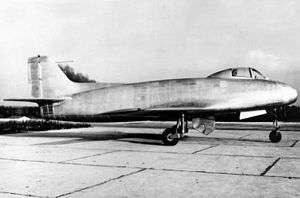Nord 2200
The Nord 2200 was a fighter aircraft developed for France's 1946 requirement for a shipboard fighter. It first flew on 16 December 1949, but it was not selected for the requirement and therefore never produced.
| Nord 2200 | |
|---|---|
 | |
| Role | Shipboard Fighter |
| National origin | France |
| Manufacturer | Nord Aviation |
| First flight | 16 December 1949 |
| Number built | 1 |
Development
SNCA du Nord (Nord Aviation) developed the aircraft to meet the shipboard fighter requirement which dictated that the aircraft be armed with three 20mm or 30mm cannon and carry 500 kg bombs or rockets. The aircraft was powered by a 22.2 kN (5,000 lbf) Hispano-Suiza Nene 102 turbojet engine and featured 24° swept wings. The prototype aircraft, ultimately the only aircraft built, did not have any armament installed, not did it have the folding wings that would be required for carrier use. The aircraft was damaged on 24 June 1950, and the rebuilt aircraft featured a larger vertical tail and space for radar in the nose, over the engine air intake. Despite continuing flight testing until 1954, a variant of the de Havilland Sea Venom, the Aquilon, was selected as the shipboard fighter for the requirement.[1]
Specifications (Nord 2200)
Data from The Complete Book of Fighters[1]
General characteristics
- Crew: 1
- Length: 13.9 m (45 ft 7 in)
- Wingspan: 12 m (39 ft 4 in)
- Height: 4.8 m (15 ft 9 in)
- Wing area: 31.6 m2 (340 sq ft)
- Empty weight: 4,830 kg (10,648 lb)
- Gross weight: 7,890 kg (17,394 lb)
- Powerplant: 1 × Hispano-Suiza Nene 102 centrifugal-flow turbojet engine, 22 kN (5,000 lbf) thrust
Performance
- Maximum speed: 963 km/h (598 mph, 520 kn)
- Rate of climb: 23 m/s (4,500 ft/min)
References
| Wikimedia Commons has media related to Nord 2200. |
- Green, William; Swanborough, Gordon, The Complete Book of Fighters : an illustrated encyclopedia of every fighter aircraft built and flown, New York: Barnes & Noble, ISBN 0-7607-0904-1